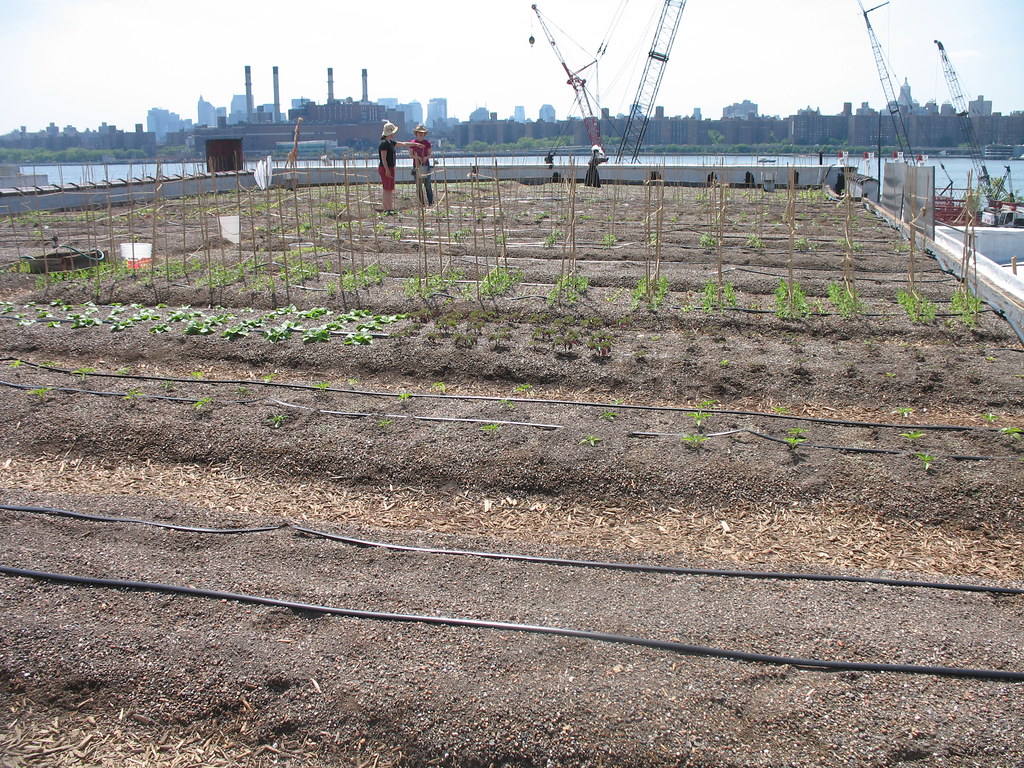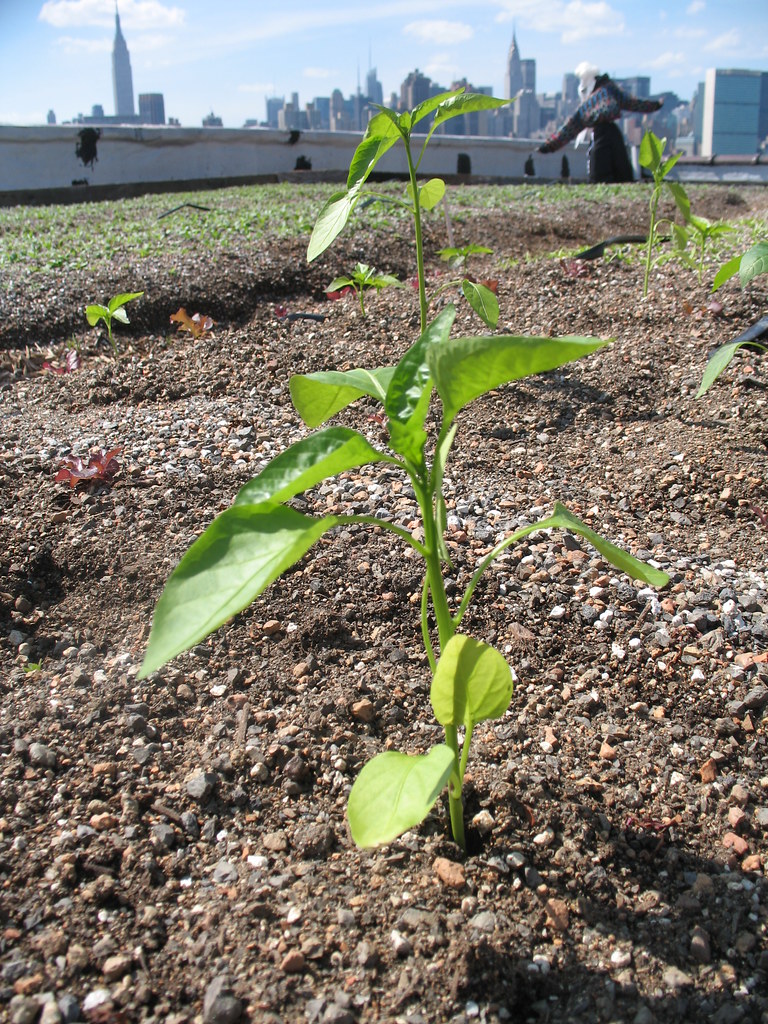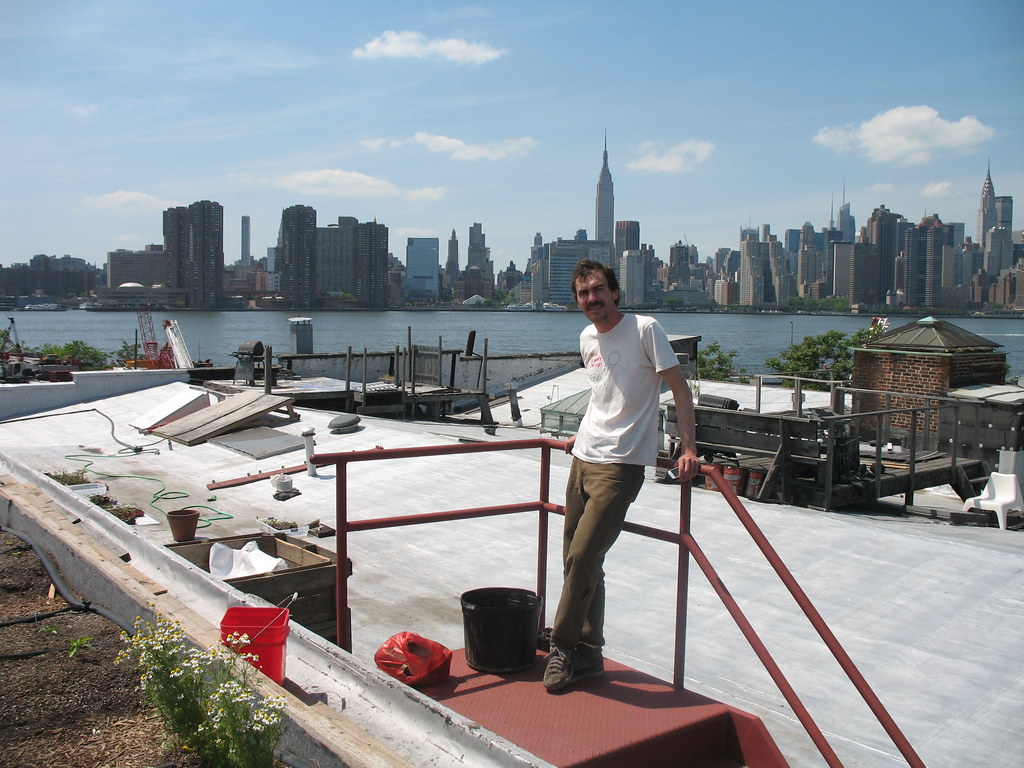
A rustic scarecrow looms before the skyline of Manhattan’s midtown skyscrapers. Under its watch lie more than 30 varieties of vegetables, fruits, flowers and herbs on a rooftop in Greenpoint, Brooklyn. But its real scarecrows, the overseers of this rooftop farming project, are Ben Flanner and Annie Novak. I asked if they’d had any problems with pest.
“Lately, we’ve just begun getting some bugs. Both good and bad bugs. But even if they’re the bad ones, bugs are a good thing, because it means that they’re beginning to recognize that there’s an ecosystem here,” Novak replied.
The bugs are taking notice, and hopefully the general public soon will, too. Similar in mission to the NY Sunworks Science Barge project, in which the nonprofit forged a viable ecosystem on a raft on the Hudson, Eagle Street Rooftop Farm is further proof that agriculture can thrive in the unlikeliest of places.
On top of an industrial building overlooking the East River, just a stone’s throw from the Pulaski Bridge, sits the 6,000 square foot urban farm. The farmers hired a crane to pour 150,000 pounds of soil onto the roof and created an irrigation system to distribute the wealth of water. A cache of seedlings ready to be transferred to the soil on the roof sits just adjacent to the rooftop, grown from seeds purchased from organic seed savers like Seed Savers Exchange. A beehive has been set on another neighboring rooftop, and on the day I visited the farm, so did a local beekeeper who was excited about lending her expertise to the project. There was talk of building a coop to hold ten or so chickens on the roof. All told, however, the directors cite a modest budget for starting their project.
 a young pepper plant
a young pepper plant
Last November, Ben Flanner read an article about Chris Goode in New York Magazine, and how he’d built several green rooftops in NYC, including his own in Soho. Then working in an office for eTrade, Flanner had been devouring books about farming all winter, and knew he’d wanted to do “something with it” that summer. The two mens’ dreams came together after Flanner contacted Goode about starting a rooftop gardening project. They eventually found an industrial warehouse on Eagle Street willing to host the rooftop farm. Owned by Broadway Stages, its cavernous interior is frequently rented by the film industry for movie sets. For a partner, Flanner was constantly referred to Annie Novak, a farmer with Kira Kenney of Evolutionary Organics.
Both originally from the Midwest — Annie, from Chicago, and Ben from Milwaukee — the two were inspired by the urban farming activity there. “Chicago is a great place for apiaries,” said Novak, who estimates there are over 3,000 are present in the windy city. While Novak has had rigorous experience in farming and farm education (she is also a Children’s Gardening Program Coordinator at the New York Botanical Garden in the Bronx, school gardening programmer with Slow Food USA, and runs the workshop Growing Chefs), Ben cites no farming experience, “just passion.” He’d debated splitting his time between his office job and running the rooftop farm before quickly realizing the demands of the farm.
It was a sunny Memorial Day when I first stepped atop the rooftop farm. On it were two women who were volunteering that day, and throughout the next hour or so, several more volunteers would pop up. The rooftop’s crops were divided into two neat sets of rows about 100 feet long and 60 feet wide, with a wood chip-strewn walking path along the midsection and in between each row. The volunteers had just direct-sown radishes that morning. The directors estimate that close to 100 people have come through the farm to help out, going through one whole crop in a day, like radishes or scallions — many of which, according to popsicle stick-sized markers planted before each row, were only transplanted to the soil about one week ago. They looked almost ready to eat.
 newly transferred scallions and beet greens
newly transferred scallions and beet greens
Taking a languid break, the farmers discussed inter-cropping the lettuces with tomatoes, so that the tall tomato plants would provide shade for its neighboring crops. Or at least, that’s what I thought I heard. Novak answered my hapless question to clarify this point with a breathless explanation on the plants just at my feet: because lettuces are one of those plants that go to flower when it gets too hot, and going to flower early will spoil the harvest, the tomatoes are inter-cropped for shade, but that’s not the case with the pepper plants that are inter-cropped with the radishes over in the next row, they’ve been put in the same bed because radishes take 35 days to harvest while the peppers take much longer, so once they’re done new crops can be put in its place.
“We want to teach as many people as possible,” said Novak, taking a seat along a bench of volunteers. Hence, my eyeballs needn’t have bulged with starry “teach-me” signs — this team is in it to educate. And without all the enormous response they’d received from various friends and volunteers, none of it could have been possible. In their call for volunteers last week, twenty people responded, out of the forty people on the email list. Both of the volunteers I chatted with had heard about the project at the Brooklyn Food Conference, too — Bruni Torras, who’d worked at Added Value farm in Red Hook last year, and Betsey McCall, who manages Murray Hill Greenmarket and teaches yoga. Learning how to grow plants can be intimidating for a lot of people, Annie observed, “because it’s a living thing and you can kill it. But just with experience you’ll get to watch how things grow,” she explained.
 Ben Flanner, one of the rooftop farm’s founders
Ben Flanner, one of the rooftop farm’s founders
Once they’re ready to harvest, the group plans to provide local restaurants and other community organizations with their crops. But only very local ones — they plan to transport everything they grow by bike. Nearby Greenpoint restaurants might be in luck, like Anella, where the group often picks up compost scraps from. The Eagle Street Rooftop Farm might also set up a stand for passer-by customers later in the summer. Ben plans on growing some hops for Sixpoint Brewery soon.
At first, Novak admitted, she’d hoped the rooftop had been smaller. Now, she wishes it were 100 times bigger: “We could be growing so much more.” It’s all a learning experience, though. If it turns out to be that cabbage, for instance, is not a good crop for rooftop farms, then they’ll try other plants out for size. A diverse ecosystem is the first goal. And whatever crops flourish, they will find that they will; and those that don’t, that they don’t. Hopefully the lessons learned will become useful for later rooftop farmers.
That is the ultimate goal of its founders, setting the mold for future rooftop farms to come. While we can all use more freshly grown produce in the city, the projects stands a testament that it can simply be done.
“I just want it to be possible, and something that’s done all over,” said Novak. “It’s amazing how nature can be squeezed into NYC.”
For more info or to lend a hand, contact rooftopfarmer[at]gmail.com.
32 Responses
Kerstin
How cool – thanks for sharing 🙂
c dawg
as a organic grower of 10+ years and growing up inand around green house’s i have to say i am impressed with this project. but i wonder how they are draining the soil after watering. Soil needs a large amount of run off from watering to prevent nutrient lock. over time when there is no run off, the nutrients build up into salts and choke the plants to a slow death. or even quick one for that matter.. this is a wonderful idea. but poor drainage can result in a failed crop. i have seen this many times.
what is the setup like? do they have the beds lifted?
interesting to say the least. GOOD LUCK with this !!! i hope it turns out well..
Stacey
Congratulations to a huge addition to the Brooklyn skyline!
No mention was made in the blog about the structure of the building. It is important to note that a structural engineer should sign off that the additional weight of soil and water(!) do not jeopardize the structural stability of the building. I have been curious myself how some of these warehouses would hold up. In the design of new buildings, whether to green-roof or not to green-roof is always one of the first questions the structural engineer asks, and growing crops is a lot more water and soil than growing a thin later of moss or grass.
Sarah
It is great to see how people use the small spaces we have in such interesting ways. I can’t wait to watch how this project works out.
Annie N.
Hey commentators–
It’s great to hear your questions–it was our first rooftop farm, so we were tyros, too. Please feel free to email us with questions: [email protected]
We’d love to help and meet you.
Annie Novak & Ben Flanner
foodcreate
We love to help!
Let us khow what you need for this project:)
amazing Thanks for sharing.
And you can visit me if I visit you:)
Welcome!
foodcreate.com
Ben
Regarding Stacey’s comment on the structure…
Yes, load is a serious concern. Not all buildings can handle the weight. You must evaulate the load-bearing capacity, and then ensure that it’s greater than the weight of the soil (fully saturated in water) + snow + additional buffer for live load (humans).
Morta Di Fame
This is an amazing idea. Wouldn’t it be so amazing in like 20 years when you fly out of JFK and see a green canopy over the city?
Important questions: When choosing a location were there any concerns with the alleged toxicity of the air and soil in Greenpoint/Williamsburg and coming off of the Newtown Creek? Will you be studying the soil and plant quality you get?
Laura Wehrman
This is amazing to hear about because I live in GP, just blocks away from the farm! I’d love to volunteer! How can I get in touch with these folks?
Scott Denton
I want to do this to my roof in Bedstuy so bad.
Alex Pogany
how deep is the soil? What are the layers down to the roof top? Where does the water go after it travels passed the roots through the soil? This is revolutionary. Thanks for being optimists and idealists.
The Future’s Looking Up on a Rooftop Farm | Urban Gardens | Unlimited Thinking For Limited Spaces
[…] Cross-posted from Not Eating in New York […]
Rooftop Farming in Brooklyn — The Pop-Up City
[…] like Chris Goode have a lot of work to do these days. Recently I came across an interesting rooftop farm project in Greenpoint, […]
The Blohg of Zeke Sikelianos » Blog Archive » Rooftop Farms, an Urban Farm in Brooklyn
[…] A Rooftop Farm for the Future […]
Preeti Patil
This is really super! We have been farming on 3000 sq ft area in the city of Mumbai, India and our work can be viewed on the blog.
Every time one sees such news reviews it just strengthens our resolve to spread the message and the technique to more and more people.
It will be nice to keep in touch and exchange our success and failures!
Best wishes
preeti
cj
we do not think this is a good idea. what about safety? I mean, the roof could collapse especially with a lot of rain. Be careful
Not Eating Out in New York » Support Urban Farming at Roberta’s Pizza Tonight
[…] menu at Roberta’s, too. The kitchen team is currently toying with hot peppers from Eagle Street Rooftop Farm, squashes from Queens County Farm Museum, root vegetables and all sorts of greens from East New […]
Doug DeCandia
Hello,
My name is Doug DeCandia. I am graduating this week from college where I am receiving my degree in sustainable agriculture. I am from the lower Hudson Valley, NY and am moving home to begin farming. I am very interested in food production initiative in NYC and taking part in it as well. I am curious if you all had any information that you could share.
Thank you very much.
-Doug
Happy Earth Day! | Upper Green Side
[…] Join a CSA, shop at the local greenmarkets or even better: eat (extremely) locally and green your roof at the same time by farming on your rooftop! […]
Urban Farming Moves to Rooftops in NYC | Explain The Plan
[…] One farm the Goodes helped develop is Rooftop Farms in Greenpoint opened in 2009, a 6,000 square foot urban farm on the roof of an industrial building. They used a crane to put the soil on the roof, and now grow a variety of vegetables and even have an apiary. Read this article from the “Not Eating Out in New York” blog about it. […]
Sheri Minero
I love how you put it. Great stuff.
Rooftop Farms, a 6,000 square foot organic vegetable farm in Brooklyn, New York. |
[…] See A Rooftop Farm for the Future here. […]
Dalton Rouser
This blog is great. I have learned lots of things from here. Thanks
ovation cc
Hello could I use a few of the insight found in this website if I supply a link back again to your site?
Blog Buzz: Growlers, Pig Roasts & Sweet 16′s | The Greenpointers
[…] I am just amazed at the crazy things that go on around here. Apparently there is a rooftop farm on Eagle Street. I shit you not. – Not Eating Out in New York via Morta Di Fame Also at New York […]
YouTube to mp4
Having bugs is a good sign indeed. Getting rid og them is not on the first place.
gardening
gardening…
[…]A Rooftop Farm for the Future » Not Eating Out in New York[…]…
siding roof repairs windows remodeling sun rooms
siding roof repairs windows remodeling sun rooms…
[…]A Rooftop Farm for the Future » Not Eating Out in New York[…]…
Ziegel Hersteller
Ziegel Hersteller…
[…]A Rooftop Farm for the Future » Not Eating Out in New York[…]…
Greenhouse
Greenhouse…
[…]A Rooftop Farm for the Future » Not Eating Out in New York[…]…
Brooklyn Rooftop Agriculture — The Pop-Up City
[…] like Chris Goode have a lot of work to do these days. Recently I came across an interesting rooftop farm project in Greenpoint, […]
bitrained
Hi! This post could not be written any better! Reading this
post reminds me of myy goood old room mate! He always kept talking about this.
I will forward this write-up to him. Pretty sude hee will have
a good read. Thank you for sharing!